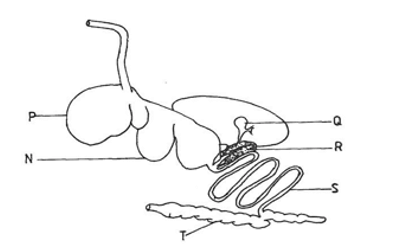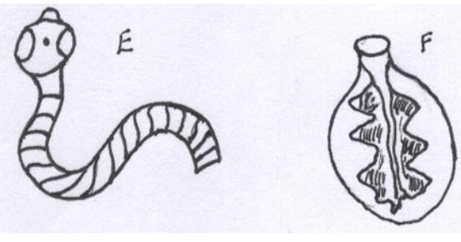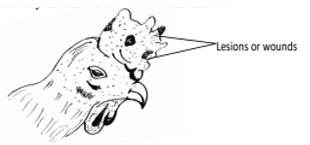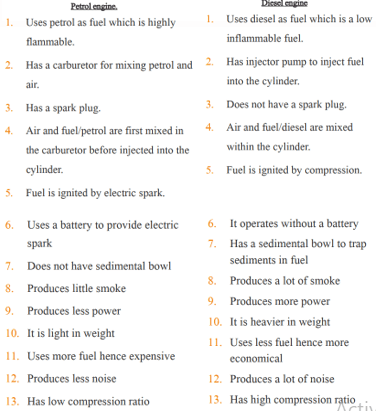INSTRUCTIONS
- This paper consists of THREE sections A, B and C
- Answer ALL questions in sections A and B and Any TWO questions in section C

QUESTIONS
SECTION A (30 MARKS)
Answer all question in this section in the spaces provided.
- Name a tool recommended for the following practices in the farm.
- Smoothening rough surface of wood. (½ mark)
- Cutting threads on pipes. (½ mark)
- Relieving a bloated animal of gases particularly ruminants. (½ mark)
- Study the table below and fill in missing names (3marks)
Description
Cattle
Pigs
Poultry
Young from birth /hatching to weaning
Chick
Young female before parturition /laying
Gilt
Mature male for breeding
Bull
- Name two livestock diseases controlled through artificial insemination (A.I) (1mark)
- Name two dairy goat breeds reared in Kenya (1mark)
- Give four reason of feeding calves on colostrum. ( 2mark)
- State four effects of tsetse fly (Glossina spp) in livestock . (2mark)
- Why is raddling essential in sheep management. (1mark)
- State four factors considered when setting a pigsty in the farm. (2mark)
- Name four sources of power in the farm (2mks)
- State four predisposing factors to the occurrence of mastitis in dairy cattle. (2mark)
- Why are the following conditions maintained during artificial incubation of eggs in poultry production?
- Proper ventilation. (1mark)
- Relative humidity maintained at 60%. (1mark)
- Give four reason for keeping a herd of dairy cattle healthy. (2mark)
- Differentiate between the following terms as used in livestock production
- Close breeding and line breeding. (1mark)
- Crutching and ringing. ( 1mark)
- State four reasons for maintaining farm tools and equipment. ( 2marks)
- Name four ways of restraining cattle during routine management. (2mark)
- State the factors that determine the amount of water an animal drinks. (2marks)
- State five causes of stress in a flock of layers. (2½ marks)
SECTION B (20MARKS)
Answer all answers to this section in the spaces provided.
- The diagram below shows part of the digestive system of livestock

- Name one livestock with the above digestive system ( 1mark)
- Name parts labelled P and N (2marks)
p………………………………………………………………………………..…..
N………………………………………………………………………….…………... - State two functions of part labelled P (2marks)
- Below shows livestock parasites study them and answer questions that follow

- Identify parasite labeled E and F. (1mark)
E…………………………………………………………………………
F………………………………………………………………………… - Name the organ in which each parasite is commonly found. (1mark)
E……………………………………………………………………………F…………………………………………………………………………… - Name the intermediate host of the parasite labeled E. (1mark)
- State two control measures of the parasite labeled F in livestock production. (2mark)
- Identify parasite labeled E and F. (1mark)
- The diagram below shows a poultry disease. Study it and answer the question that follow

- Identify the disease. ( ½ mark)
- State the causative agent of the above. ( ½ mark)
- Apart from wounds or lesions or state any other two symptoms of the above disease (2marks)
- State two control measures of the above (2marks)
- The diagram below is an illustration of an egg. Study it carefully and answer the questions that follow.

- Name the parts labelled A, B, C, and D.
A…………………………………………………………………………... (½ mark)
B…………………………………………………………………………. (½ mark)
C……………………………………………………………………………. (½ mark)
D………………………………………………………………………… (½ mark) - State two qualities that should be considered when selecting eggs for incubation (2mark)
- What is the function of the part labelled C in a fertilized egg (1mark)
- Name the parts labelled A, B, C, and D.
SECTION C (40 MARKS)
Answer any two questions from this section in the spaces provided
-
- Describe the process of milk secretion (5marks)
- outline the advantages of battery cage system of rearing poultry ( 8marks)
- Describe various management carried out in a fish pond to ensure maximum harvest of fish (7marks)
-
- Describe general methods of controlling livestock diseases (10marks)
- Give eight differences between a petrol and diesel engine (10marks)
-
- Describe the process of egg formation in the reproductive system of a hen ( 12marks)
- Describe the ideal characteristics of an ideal calf pen ( 8marks)

MARKING SCHEME
- Smoothening rough surface of wood- Plane ½
- Cutting threads on pipes- pipe wrench ½
- Relieving a bloated animal of gases particularly ruminants. – Trocar and canula ½
- Study the table below and fill in missing words (3marks)
Description
Cattle
Pigs
Poultry
Young from birth /hatching to weaning
Calf
piglet
Chick
Young female before parturition /laying
Cow
Gilt
pullet
Mature male for breeding
Bull
boar
Cock
- Name two livestock diseases controlled through artificial insemination (A.I) (1mark)
- Brucellosis /contagious abortion or bangs disease
- Vaginitis
- Orchitis ( ½ x2=1)
- Name two dairy goat breeds reared in Kenya (1mark)
- Jamnapari
- Saanen
- Toggenburg
- British alpine
- Anglo Nubian ( ½ x2=1)
- Give four reason of feeding calves on colostrum.
- It is highly digestible.
- It contains antibiotics.
- It is highly nutritious.
- It serves as a laxative.
- It is highly palatable. ( ½ x4=2)
- State four effects of tsetse fly (Glossina spp) in livestock .
- Sucking blood causing anemia
- Cause irritation on the skin of the host.
- Destruction of hides and skins.
- Transmission of diseases e.g trypanosomiasis ( ½ x4=2)
- Why is raddling essential in sheep management.
- Helps to identify mated ewes and to indicate the active rams hence help in culling of the weak rams. ( 1 x1=1)
- State four factors considered when setting a pigsty in the farm.
- The location of the homestead.
- Accessibility.
- Security.
- Drainage/topography.
- Wind direction.
- Relationship between the structures.
- Proximity to social amenities.
- Farmer's taste and preference. ( ½ x4=2)
- Sources of power in the farm (2mks)
- Human power
- Animal power
- Electrical power
- Solar power
- Biomass
- Wind power
- Water power
- Fossil power ( ½ x4=2)
- State four predisposing factors to the occurrence of mastitis in dairy cattle
- Incomplete milking.
- Injuries on the udder and teats.
- Weak sphincter muscles of the teats allowing free flow of milk.
- Older animals are more likely to be infected
- Stage of lactation period
- Poor sanitation ( ½ x4=2)
- Why are the following conditions maintained during artificial incubation of eggs in poultry production?
- Proper ventilation. -facilitate gaseous exchange and helps to control humidity ( 1x1=1)
Relative humidity maintained at 60% -low temperature causes embryo to lose moisture and die while high temperature lowers hatchability and leads to production of bigger chicks 1mk
- Proper ventilation. -facilitate gaseous exchange and helps to control humidity ( 1x1=1)
- Give four reason for keeping a herd of dairy cattle healthy
- Healthy animals give high income due to low treatment costs.
- The productive life span of a healthy animal is longer.
- High production.
- Healthy animals can multiply regularly.
- Healthy animals give high quality products for example eggs.
- Safety of consumers of livestock products. ( ½ x4=2)
- Differentiate between the following terms as used in livestock production
- Close breeding and line breeding. (1mark)
Close breeding is the breeding 0f closely related animal eg sister and brother while line breeding is mating of distantly related animal that share common ancenstry - Crutching and ringing. ( 1mark)
Crutching - cutting of wool around the external reproductive organs of female sheep. Ringing - trimming wool around the sheath of the penis of the rams to facilitate mating.
- Close breeding and line breeding. (1mark)
- State four reasons of maintaining farm tools and equipment
- To increase durability.
- To increase efficiency.
- Reduce costs of replacement.
- For safety of the user/avoid accidents.
- Avoid damage to the tool. ( ½ x4=2)
- Name four ways of restraining cattle during routine management.
- ropes,
- halters,
- lead stick and bull rings
- crush
- use of a head yoke ( ½ x4=2)
- State the factors that determine the amount of water an animal drinks.
- Production level.
- Amount of dry matter eaten.
- Temperature of the surrounding area.
- Type of animal.
- Type of food eaten. ( ½ x4=2)
- State five causes of stress in a flock of layers.
- Sudden changes in routine management.
- Presence of strangers in the poultry house.
- Presence of animals and vermins.
- Too much noise.
- Constant and poor handling.
- Sudden weather changes.
- Disturbance of the pecking order.
- Overcrowding
- Poor hygiene.
- Disease and pest attack.
- Lack of food and water ( ½ x5=2 ½ )
SECTION B
-
- Animals with the type of stomach (1mk)
Cattle, sheeps, goats - Name part; (2mks)
P= Rumen
N= Omasum - Functions of part P (2mks)
- Temporary storage of food
- Fermentation of food
- Microbial digestion
- Animals with the type of stomach (1mk)
-
- Identify parasite labeled E and F. (1mark)
E -tapeworm
F -liverfluke - Name the organ in which each parasite is commonly found. (1mark)
E- small intestine
F- liver - Name the intermediate host of the parasite labeled E. (1mark)
pigs
cow - State two control measures of the parasite labeled F in livestock production. (2mark)
- Keep livestock off marshy areas near the rivers/streams/lakes and dams.
- Drench affected animals.
- Drainage of swampy areas.
- Eradicate the intermediate host by use of molluscicides.
- Provide water to livestock in elevated troughs.
- Identify parasite labeled E and F. (1mark)
-
- Identify the disease. ( ½ mark)
- Fowl pox
- State the causative agent of the above. ( ½ mark)
- Virus/ avian fox
- Apart from wounds or lesions or state any other two symptoms of the above disease (2marks)
- Injuries in the inside of the throat and mouth membranes resulting in difficult breathing and swallowing.
- Eyes and nose produces a watery liquid.
- Loss of appetite.
- Dullness.
- Emaciation.
- State two control measures of the above (2marks)
- The affected birds should be removed and killed
- The remaining healthy birds should be vaccinated
- Identify the disease. ( ½ mark)
-
- Name the parts labelled A, B, C, and D.
- A albumen (½ mark)
- B air space (½ mark)
- C yolk (½ mark)
- D chalazae (½ mark)
- State two qualities of the part labelled A that should be considered when selecting eggs for incubation (2mark)
- Should be fertile.
- Should be of medium size about 55- 60gms in weight.
- Should have smooth shell.
- Should be oval shaped.
- Should not be cracked.
- Eggs should be clean to ensure that pores are open.
- Should not have abnormalities such as blood spots, meat spots and double yolk.
- Eggs should not be more than 5 days old.
- Eggs should be fresh that is collected within one week. ( 2x1 =2)
- What is the function of the part labelled C in a fertilized egg (1mark)
- Contains food reserve for the developing embryo.
- Name the parts labelled A, B, C, and D.
SECTION C
-
- Describe the process of milk secretion ( 5marks)
- The process of milk secretion is known as lactogenesis.
- The digested food is taken to the udder via blood vessels.
- In the udder the nutrients are carried into the alveoli cells where metabolic reactions take place to build up these nutrients into milk.
- A hormone prolactine is secreted by pituitary gland which brings about lactogenesis.
- The milk secreted is then stored in the upper parts of the udder waiting to be released. ( 5x1 =5)
- Advantages of battery cage system
- Records are easily kept therefore culling is easy.
- Birds do not become broody.
- More eggs are collected due to restricted movement of the hens and complete control of egg eating.
- Tender meat is obtained from the culls because the muscles have not been toughened much.
- Handling is easier than in the other systems and individual attention to hens is given.
- Stocking rate is very high.
- Vices are greatly reduced.
- Eggs are clean because hens do not step on them.
- The system can easily be mechanised.
- Birds do not contaminate the food and water.
- Sick birds can be detected easily and isolated for treatment.
- Wire floors prevent re-infestation of parasitic worms and coccidiosis.
- No bullying during feeding.
- Low labour requirement. ( 8x1 =8)
- Describe various management carried out in a fish pond to ensure maximum harvest of fish
- Control of stocking rate, that is to, have the recommended population of fish in a pond at anyone time.
- Harvest at the correct maturity stage.
- Avoid water pollution in the ponds which may poison fish.
- Ensure adequate supply of food in the pond.
- Water in the ponds should be kept in motion to facilitate aeration.
- Maintain appropriate depth (level) of water.
- Control predators and/or thieves.
- Drain and refill ponds with fresh water as necessary.
- Manuring the pond ( 7x1 =7)
- Describe the process of milk secretion ( 5marks)
-
- Describe general methods of controlling livestock diseases
- Quarantine
- Vaccination.
- Control of vectors by use of acaricides and rotational grazing.
- Disinfecting the equipment and buildings.
- Use of preventive drugs.
- Proper feeding of livestock.
- Culling of the animals which are carriers/slaughtering the affected animals.
- Use of artificial insemination to control breeding diseases. Proper selection and breeding of animals.
- Proper housing and hygiene,
- Isolating sick animals. ( 10x1 =10)
- Structural and Functional Differences Between Petrol and Diesel Engines ( 10x1 =10)

- Describe general methods of controlling livestock diseases
-
- Describe the process of egg formation in the reproductive system of a hen ( 12marks)
Ovary- Hen has two ovaries but one functional.
- Ova formed in ovaries.
Funnel(infundibulum)- Fertilization occurs here.
- Chalazae also added to yolk.
Magnum- Thick albumen is added.
Isthmus- Shell membranes added.
- Determines shape of egg.
- Water, mineral salts and vitamins added.
Uterus(shell gland)- Calcium deposited I;e.shell added around the egg.
- Addition of albumin finished.
Vagina- For temporal storage of egg before laying
Cloaca- Egg moves out of cloaca through the vent.
- The cloaca extents out to prevent the egg from breaking
( 6x2 =12) stating =1 explaining =1
- For temporal storage of egg before laying
- Thick albumen is added.
- Describe the ideal characteristics of an ideal calf pen
- Easy to clean- they should have concrete floor to facilitate cleaning.
- Dry and warm- dry litter should be placed on the floor to avoid dampness/ wetness.
- Adequate space- it should be spacious for exercise, feeding and watering calves.
- Proper lighting- it should be well lit because light is necessary for synthesis of vitamin D.
- Proper drainage- should be constructed on a well drained place to avoid dampness.
- Proper ventilation- to allow free air circulation.
- Draught free- to prevent entry of cold winds and discourage infections e.g. pneumonia.
- Single housing-to prevent disease and parasite spread and to prevent the formation of hair balls in the stomach.
- Leak proof- the roof should not leak or avoid spilling water on the floor to discourage dampness and wetness of litter.
- Describe the process of egg formation in the reproductive system of a hen ( 12marks)
Download Agriculture Paper 2 Questions and Answers - Wahundura Boys Mock Examination 2023.
Tap Here to Download for 50/-
Get on WhatsApp for 50/-
Why download?
- ✔ To read offline at any time.
- ✔ To Print at your convenience
- ✔ Share Easily with Friends / Students
